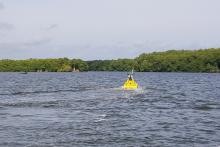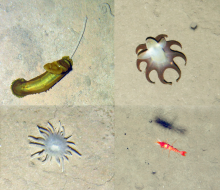CAMEL Capabilities, Equipment and Specification
Find out more about the CAMEL Capabilities, Equipment and Specification
The capacity of many Small Island Developing States to conduct marine scientific research within their extended economic zones is limited by the fact that they cannot afford to design, build and operate the research vessels required to achieve the necessary geographic coverage or sampling rate. In order to address this limitation and provide beneficiary countries and remote areas with access to state-of-the-art scientific equipment, this project supported the development and deployment of the Containerised Autonomous Marine Environmental Laboratory (CAMEL) – a fully containerised facility housing autonomous systems that can be used to map and monitor marine environments which can be shipped to any port and deployed from a quayside, beach or vessel.
The CAMEL facility comprises multiple innovations that enable marine scientific research and hydrographic surveying in remote and/or unsupported locations. One of the principal assets is the autonomous (unnmaned) surface vessel (USV) that has three separate payloads (Hydrographic; Oceanographic and Geophysical) for subsea scientific data collection. In addition the facility includes two 20’ ISO containers that function as an Operations Room and a Workshop during a deployment, a portable Remotely Operated Vehicle (ROV), a micro autonomous underwater vehicle (AUV), a wave measuring buoy with GPS, a sound velocity profiler and an inflatable boat with outboard engine. Full details on the capabilities of the facility and equipment specifications are provided here.
To date, the CAMEL Facility has been successfully deployed for scientific data collection twice in Belize (in 2018 and 2019), and once in Dominica (in 2019). The deployments in Belize provided vital information quantifying the impact of land use change on coastal marine environments, and supported related work on ocean acidification, coral health and carbon capture by natural ecosystems. The deployment in Dominica enabled new marine habitat maps to be produced for two protected marine areas.
Portable marine science lab returns to Belize Nov 2019
 Scientists and engineers from the National Oceanography Centre (NOC) were in Belize in October conducting research as part of an ongoing programme of collaborative multi-disciplinary fieldwork that aims to help understand the impacts of climate change and human activities on coastal environments.
This work is part of a research campaign funded by the UK Government’s Commonwealth Marine Economies (CME) Programme, that involves NOC scientists working alongside colleagues from the...
Scientists and engineers from the National Oceanography Centre (NOC) were in Belize in October conducting research as part of an ongoing programme of collaborative multi-disciplinary fieldwork that aims to help understand the impacts of climate change and human activities on coastal environments.
This work is part of a research campaign funded by the UK Government’s Commonwealth Marine Economies (CME) Programme, that involves NOC scientists working alongside colleagues from the... |
Characterising the environmental sensitivity of Belizean coastal waters Oct 2019
 A month long fieldwork campaign has begun in Belizean coastal waters which will enhance understanding of the sensitivities of these fragile environments to the impacts of both human activities and climate change.
Dr Christopher Pearce, programme lead for the NOC, said “Belizean coastal environments are some of the most fragile in the world, and are facing a combination of challenges from both human and climate change factors.
In collaboration with our Belizean colleagues we will be...
A month long fieldwork campaign has begun in Belizean coastal waters which will enhance understanding of the sensitivities of these fragile environments to the impacts of both human activities and climate change.
Dr Christopher Pearce, programme lead for the NOC, said “Belizean coastal environments are some of the most fragile in the world, and are facing a combination of challenges from both human and climate change factors.
In collaboration with our Belizean colleagues we will be... |
High biodiversity discovered in abyssal areas of Kiribati Sep 2019
 A study led by National Oceanography Centre (NOC) scientists, recently published in Frontiers in Marine Science, presents the first ever images of animals living below 4000 metres within the Exclusive Economic Zone (EEZ) of the Republic of Kiribati, a remote island group in the Pacific.
Industry-collected seabed photos revealed a high diversity, but low abundance, of complex animals. The majority of the observed seabed life was single-celled giant forams. This is comparable to similar...
A study led by National Oceanography Centre (NOC) scientists, recently published in Frontiers in Marine Science, presents the first ever images of animals living below 4000 metres within the Exclusive Economic Zone (EEZ) of the Republic of Kiribati, a remote island group in the Pacific.
Industry-collected seabed photos revealed a high diversity, but low abundance, of complex animals. The majority of the observed seabed life was single-celled giant forams. This is comparable to similar... |